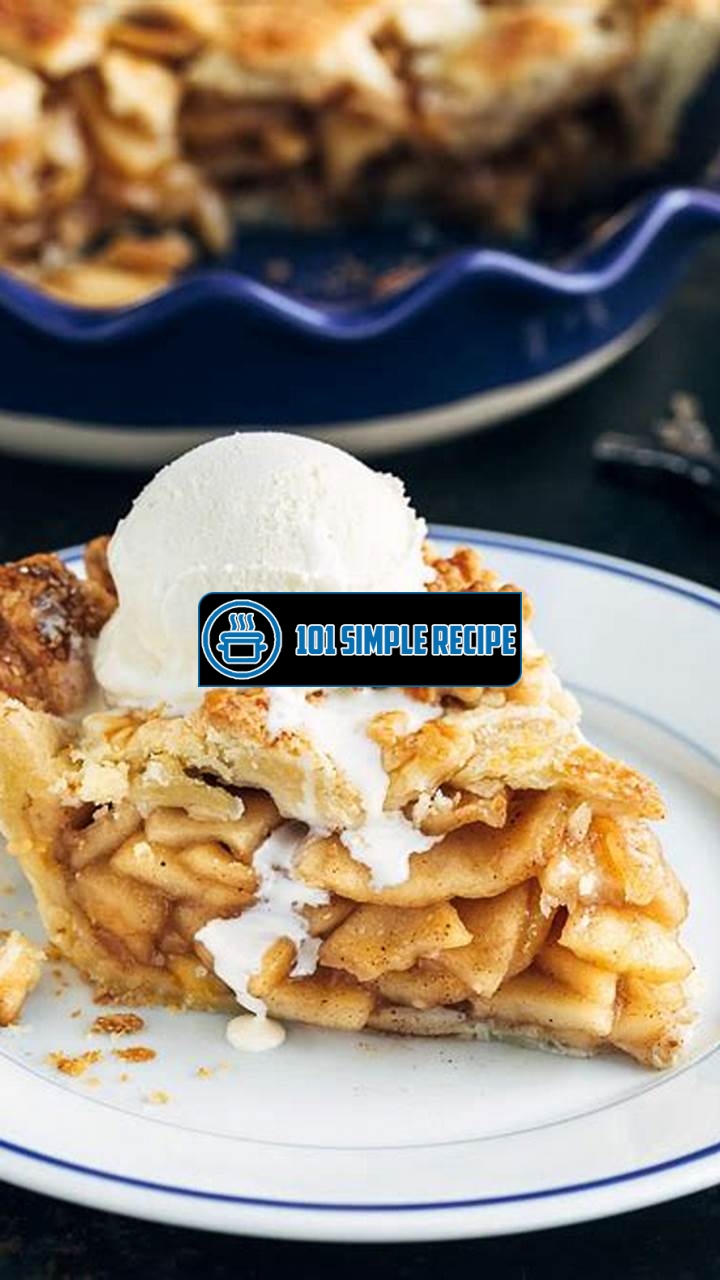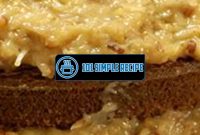Welcome to the ultimate guide on how to make the best homemade apple pie! If you’re craving the warm and comforting flavors of apple pie, look no further. This article will take you through a step-by-step process of creating a delicious pie from scratch. From selecting the perfect apples to achieving a flaky crust, we’ve got you covered. So, put on your apron and get ready to impress your friends and family with a mouthwatering homemade apple pie that will have them coming back for seconds. ️✨

Exploring the World of Homemade Apple Pie
Discover the art of making a delicious homemade apple pie from scratch, with tips and tricks to elevate your baking skills.
The Origins of Apple Pie
Apple pie is a beloved dessert that has been enjoyed for centuries. Its origins can be traced back to medieval England, where it was often made with a crust made of coarse, unleavened dough. As time went on, the recipe evolved and became sweeter and more refined.
Fun fact: The first apple pie recipe ever recorded dates back to the 14th century in England!
The popularity of apple pie spread to other European countries, and it eventually made its way to America with the early settlers. Over time, apple pie became firmly ingrained in American culture and is now considered a quintessential American dessert.
Did you know? Apple pie is so highly regarded in the United States that it is often referred to as “as American as apple pie”!
The Perfect Apple Varieties for Pie
When it comes to making the perfect homemade apple pie, choosing the right apple variety is crucial. The texture and flavor of the apple can greatly impact the overall taste of the pie.
Tip: It’s best to use a combination of tart and sweet apples to achieve a well-balanced flavor in your pie.
Some of the best apple varieties for pie include:
- Granny Smith: These tart and crisp apples hold their shape well when baked.
- Honeycrisp: Known for their sweet and juicy flavor, they add a refreshing element to the pie.
- Braeburn: With a perfect balance of sweet and tart, these apples are excellent for baking.
- Jonathan: These apples are slightly tart and have a firm texture, making them ideal for pie fillings.
Experimenting with different apple varieties can be a fun way to add unique flavors to your homemade apple pie. Don’t be afraid to mix and match to find your perfect combination!
Essential Ingredients for Homemade Apple Pie
To create a delicious homemade apple pie, you’ll need a handful of essential ingredients:
- Apples: Choose your favorite apple variety or a combination of varieties, as mentioned earlier.
- Flour: All-purpose flour is commonly used for the pie crust.
- Butter: Cold unsalted butter is essential for creating a flaky and tender crust.
- Sugar: Granulated and brown sugar add sweetness to the filling and crust.
- Spices: Cinnamon, nutmeg, and a pinch of salt enhance the flavors of the pie.
- Lemon juice: A squeeze of fresh lemon juice adds a tangy brightness to the filling.
- Egg: An egg wash helps give the pie crust a golden and shiny appearance.
Pro tip: Don’t forget a pie dish, rolling pin, and parchment paper for a smooth baking process.
Now that you have a better understanding of the origins of apple pie, the perfect apple varieties to use, and the essential ingredients needed, you’re ready to embark on your homemade apple pie journey. Get ready to create a pie that will impress your family and friends!
The Key Steps to Creating the Perfect Crust
Creating the perfect crust for your homemade apple pie is the key to making it truly exceptional. A flaky and buttery crust that complements the apple filling is what sets a mediocre pie apart from a truly mouthwatering one. Mastering the art of pie crust requires attention to detail and a few essential steps. In this section, we will explore the key steps to creating the perfect crust for your homemade apple pie.
Choosing the Right Flour for Pie Crust
When it comes to pie crust, choosing the right flour is crucial. The type of flour you use can significantly impact the texture and flavor of your crust. All-purpose flour is a popular choice for pie crusts. It strikes a good balance between tenderness and flakiness. However, if you prefer a more tender and delicate crust, you can opt for pastry flour, which has a lower protein content. Alternatively, if you desire a crust with a hearty and rustic texture, you can use whole wheat flour. Experiment with different types of flour to find the one that best suits your taste preferences.
An important point to keep in mind is that it is best to measure the flour properly. Too much flour can result in a dry and tough crust, while too little can make it crumbly and fragile. Use a kitchen scale or lightly spoon the flour into a measuring cup and level it off with a knife for accurate measurements.
The Role of Fat in Creating Flakiness
Fat is a crucial ingredient in creating a flaky pie crust. The choice of fat can vary depending on personal preference and dietary restrictions. Traditional pie crust recipes often call for butter, which adds richness and flavor. Butter also creates pockets between the layers of dough, resulting in a tender and flaky texture. However, if you prefer a lighter and more delicate crust, you can use vegetable shortening or lard.
To achieve the perfect flakiness, it’s important to ensure that your fat is cold. Cold fat creates a crumbly texture in the dough and prevents it from becoming greasy. Cut your fat into small pieces and refrigerate them beforehand to keep them cold until you’re ready to incorporate them into the dough.
Secret Techniques for Rolling Out the Dough
Once you have prepared your dough, rolling it out correctly is essential. Roll your dough on a lightly floured surface, using a rolling pin. Start at the center of the dough and roll outward, applying even pressure. Rotate the dough occasionally to maintain a circular shape.
Here’s a useful tip: if your dough becomes difficult to handle or starts to stick, place it in the refrigerator for a few minutes to firm up. This will make it easier to roll out and transfer into your pie dish without tearing or stretching.
Remember not to overwork the dough. Excessive handling can make it tough and chewy. Aim for a thickness of about ⅛ inch for a thin and delicate crust or ¼ inch for a sturdier crust that can hold ample filling.
By following these secret techniques, you can ensure that your pie crust turns out perfect every time. The result will be a beautifully golden and flaky crust that provides the ideal base for your delicious homemade apple pie.
Creating the Irresistible Apple Filling
When it comes to homemade apple pie, the filling is the star of the show. It’s what brings that delectable flavor and irresistible texture that everyone loves. In this section, we will guide you through the process of creating a perfectly balanced and flavorful apple filling that will make your pie shine.
Choosing the Right Apples for a Perfect Balance
When selecting apples for your homemade apple pie, it’s important to choose the right variety to achieve the perfect balance of sweetness and tartness.
Popular choices for apple pie include Granny Smith, Honeycrisp, and Golden Delicious. Granny Smith apples provide a tart and crisp flavor, while Honeycrisp and Golden Delicious add a touch of sweetness. Combining these varieties will result in a harmonious flavor profile for your pie.
Remember to always use fresh, firm apples that are free from bruises or blemishes. This ensures that your filling will have the ideal texture and consistency.
Enhancing the Flavor with Spices and Sweeteners
To take your apple filling to the next level, adding a combination of spices and sweeteners is key. The perfect blend of flavors will elevate your pie and have your taste buds dancing with delight.
Cinnamon is a classic spice that pairs exceptionally well with apples. Its warm and cozy flavor adds depth and complexity to the filling. nutmeg, allspice, and cloves can also be used to enhance the overall taste. Just a pinch of these spices can make a significant difference.✨
When it comes to sweeteners, granulated sugar and brown sugar are commonly used in apple pie recipes. Brown sugar adds a hint of caramel flavor that pairs wonderfully with the apple filling. Additionally, a squeeze of fresh lemon juice can help balance the sweetness and brighten the flavors.
Preventing a Runny or Soupy Filling
No one wants a runny or soupy apple pie filling. To avoid this culinary catastrophe, there are a few steps you can take to ensure your filling stays thick and firm.
One of the most important factors is to choose the right apples. As mentioned earlier, using firm and fresh apples will prevent excess moisture from seeping into the filling.
Another trick is to let the apple slices sit with sugar and spices for about 30 minutes before assembling the pie. This allows them to release their juices and prevents the filling from becoming too watery.
Additionally, using a thickening agent such as cornstarch or flour can help absorb any excess liquid. Be sure to follow the recipe’s instructions on how much thickener to use to achieve the perfect consistency. ✨
By following these tips, you can enjoy a homemade apple pie with a luscious and firm filling that holds its shape with each delicious slice.
Baking and Serving your Homemade Apple Pie
Now that you’ve gone through the process of creating a delicious homemade apple pie, it’s time to focus on the final steps that will truly make your pie stand out. These steps will not only enhance the taste and appearance of your pie, but they will also impress your guests with a showstopper dessert.
Perfecting the Golden Brown Crust
Creating the perfect golden brown crust is crucial for a visually appealing and flavorful homemade apple pie. The crust should have a beautiful, rich color that adds to the overall presentation of the pie. To achieve this, it’s important to follow a few key steps:
- Brush the crust with an egg wash: Before baking, lightly beat an egg and brush it over the top of the crust. This will give the crust a glossy appearance and enhance the browning.
- Sprinkle sugar on top: For an extra touch of flavor and texture, sprinkle some sugar over the crust. This will create a sweet, crunchy topping.
- Cover the edges with foil: To prevent the crust from becoming too dark or burning, cover the edges with foil during the initial baking time. This will allow the center of the pie to cook thoroughly without sacrificing the appearance of the crust.
- Bake at the right temperature: Follow the recipe instructions for the recommended temperature and baking time. This will help ensure that the crust bakes evenly and achieves the desired golden brown color.
Allowing the Pie to Cool for Optimal Results
Allowing your homemade apple pie to cool properly is critical for achieving optimal taste and texture. When the pie is hot out of the oven, the filling is still very soft and needs time to set. Here are a few tips to ensure your pie cools effectively:
- Cool on a wire rack: Transfer the pie from the oven directly onto a wire rack. This allows air to circulate around the pie, preventing the crust from becoming soggy.
- Let it cool for at least two hours: It’s essential to resist the temptation to cut into the pie right away. Give it at least two hours to cool completely, as this will help the filling thicken and set properly.
- Store at room temperature: Once the pie has cooled completely, you can cover it loosely with foil or plastic wrap and leave it at room temperature. Avoid refrigerating the pie, as this can make the crust lose its crispness.
Tips for Serving and Pairing with Ice Cream or Whipped Cream
Serving your homemade apple pie with the right accompaniments can elevate the dessert experience. Whether you choose to serve it with a scoop of ice cream or a dollop of whipped cream, here are some tips to enhance the overall taste:
- Ice cream pairing: Serving warm apple pie with a scoop of vanilla ice cream creates a delightful combination of flavors and temperatures. The creamy sweetness of the ice cream complements the warm pie filling.
- Whipped cream topping: If you prefer a lighter option, consider topping your homemade apple pie with freshly whipped cream. The airy texture and subtle sweetness of the cream provide a delicate balance to the rich flavors of the pie.
- Add caramel sauce or cinnamon: For an extra burst of flavor, drizzle caramel sauce over the pie or sprinkle a pinch of cinnamon on top. These additions will enhance the taste and add an extra touch of indulgence.
By following these final steps for baking, cooling, and serving your homemade apple pie, you’ll create a dessert masterpiece that will impress your guests with both its visual appeal and delectable taste. Enjoy!
Troubleshooting Common Apple Pie Issues
Address common challenges faced during the apple pie-making process and find solutions to ensure your pie turns out amazing every time.
Dealing with Soggy Bottom Crust
One of the most common issues faced when baking an apple pie is dealing with a soggy bottom crust. Nobody wants a pie with a crust that is not crispy and flaky. Fortunately, there are a few simple steps you can take to avoid this problem.
1. Pre-bake the bottom crust: Before adding the apple filling, blind bake the bottom crust for about 10 minutes. This helps to create a barrier between the juicy filling and the crust, preventing it from becoming soggy.
2. Drain the apple filling: After slicing the apples and tossing them with sugar and spices, let them sit for about 30 minutes. This will draw out some of the moisture from the apples. Drain the excess liquid before adding the filling to the crust.
3. Use a slotted spoon: When transferring the apple filling to the pie crust, use a slotted spoon to drain any remaining liquid. This will ensure that the excess moisture doesn’t end up in the pie.
4. Brush the bottom crust with egg wash: Before adding the filling, brush the bottom crust with a beaten egg. This creates a protective layer that helps to seal the crust and prevent it from getting soggy.
5. Elevate the pie: Another trick to prevent a soggy bottom crust is to bake the pie on a preheated baking stone or a baking sheet. The elevated heat will help to crisp up the bottom crust.
By following these tips, you can enjoy a delicious apple pie with a perfectly crisp and flaky bottom crust every time. Say goodbye to the disappointment of a soggy crust!
Preventing Overcooked or Undercooked Apples
When it comes to making apple pie, achieving the perfect texture for the apples is key. Nobody wants apples that are mushy or undercooked. Here are some steps you can take to ensure your apples are cooked to perfection.
1. Choose the right apples: Not all apples are created equal when it comes to baking. Look for apples that are firm and slightly tart, such as Granny Smith or Honeycrisp. These varieties hold their shape well during baking.
2. Slice apples evenly: To ensure even cooking, make sure to slice your apples into uniform-sized pieces. This will help them cook at the same rate and avoid some pieces being overcooked while others remain undercooked.
3. Pre-cook the apples: If you’re using a more tart variety of apples, you can pre-cook them before adding them to the pie crust. This will soften them slightly and ensure that they are fully cooked by the time the pie is done.
4. Avoid overcrowding: When filling the pie crust with the apple mixture, make sure not to overfill it. Leave some space for the apples to expand during baking. Overcrowding can lead to uneven cooking and undercooked apples in the center.
5. Check for doneness: Test the doneness of the apples by inserting a sharp knife into the pie. The apples should be tender but not mushy. If they are still too firm, continue baking for a few more minutes and check again.
By following these steps, you can ensure that your apple pie has perfectly cooked apples with a tender but firm texture.
Fixing a Cracked or Shrunken Pie Crust
There’s nothing more disheartening than pulling a beautiful apple pie out of the oven only to discover that the crust has cracked or shrunken. But fear not, as there are a few simple fixes for this common issue.
1. Patch up the cracks: If your pie crust has cracked during baking, don’t panic. Allow the pie to cool completely, then mix a small amount of flour and water to create a paste. Use this paste to patch up the cracks by gently pressing it into the crevices. Afterward, brush the patched areas with egg wash to help them blend into the rest of the crust.
2. Use a lattice top crust: If you’re prone to shrunken crusts, try using a lattice top instead of a solid crust. The lattice design allows for more even heat distribution, which can help prevent the crust from shrinking.
3. Blind bake the crust: To prevent a shrunken crust, consider blind baking the bottom crust before adding the filling. This involves partially baking the crust without the filling to set it and ensure it holds its shape during baking.
4. Chill the crust before baking: After fitting the crust into the pie dish, place it in the refrigerator for at least 30 minutes. This helps to relax the gluten in the dough and prevent shrinkage during baking.
5. Use a pie crust shield: If you notice that the edges of your pie crust are browning too quickly or starting to shrink, consider using a pie crust shield. This can be a specialized shield made of aluminum or even a makeshift shield made of aluminum foil. The shield will protect the crust from excess heat, allowing it to bake more evenly.
With these helpful tips, you can fix cracks and prevent shrinking, ensuring that your apple pie comes out of the oven with a beautiful and intact crust every time.
Thank you for taking the time to read this article about homemade apple pie. We hope you found it informative and helpful in your quest for the perfect dessert. Whether you’re an experienced baker or just starting out, making a homemade apple pie is a rewarding experience that can be enjoyed by everyone. So grab your apron, roll up your sleeves, and get ready to create a delicious treat that will have your friends and family begging for more.
Frequently Asked Questions
Here are some frequently asked questions about homemade apple pie:
| No. | Questions | Answers |
|---|---|---|
| 1 | What type of apples should I use? | It is best to use a mixture of tart and sweet apples, such as Granny Smith and Honeycrisp, to achieve the perfect balance of flavors in your apple pie. |
| 2 | Should I peel the apples? | Yes, it is recommended to peel the apples before using them in your pie. This ensures a smooth texture and eliminates any bitterness from the apple skins. |
| 3 | Can I use pre-made pie crust? | While pre-made pie crust can be convenient, nothing beats the taste and texture of a homemade crust. If you have the time, we highly recommend making your own. |
| 4 | How do I prevent a soggy bottom crust? | To prevent a soggy bottom crust, you can blind bake the pie crust before adding the filling. This involves partially baking the crust without the filling, then adding the filling and finishing the baking process. |
| 5 | Can I make the pie ahead of time? | Yes, you can make the pie ahead of time and store it in the refrigerator for up to 2 days. Just make sure to let it come to room temperature before serving, or reheat it in the oven for a few minutes. |
| 6 | What can I serve with apple pie? | Apple pie pairs well with a scoop of vanilla ice cream or a dollop of whipped cream. You can also serve it with a drizzle of caramel sauce for an extra indulgent touch. |
Thank You for Reading!
We hope you enjoyed learning about homemade apple pie and feel inspired to give it a try. There’s something truly special about the aroma of freshly baked apple pie filling your kitchen, and the satisfaction of taking your first bite of a warm slice. We encourage you to bookmark this page and visit again later for more delicious recipes and baking tips. Happy baking!
Jump to Recipe
Homemade Apple Pie

Learn how to make a delicious homemade apple pie with this easy-to-follow recipe. Perfect for any occasion or as a comforting dessert.
- 2 1/2 cups all-purpose flour
- 1 cup unsalted butter (cold and cubed)
- 1/4 cup granulated sugar
- 1/4 cup ice water
- 6-7 medium apples (peeled, cored, and sliced)
- 1/2 cup granulated sugar
- 1/4 cup all-purpose flour
- 1 teaspoon ground cinnamon
- 1/4 teaspoon ground nutmeg
- 1 tablespoon lemon juice
- 1 tablespoon unsalted butter (melted)
- In a large mixing bowl, combine the flour and sugar. Add the cold, cubed butter and use a pastry blender or your fingers to cut the butter into the flour mixture until it resembles coarse crumbs. Gradually add the ice water, mixing with a fork, until the dough comes together. Divide the dough in half, shape each half into a disk, wrap in plastic wrap, and refrigerate for at least 1 hour.
- Preheat your oven to 375°F (190°C).
- In a large mixing bowl, combine the sliced apples, sugar, flour, cinnamon, nutmeg, and lemon juice. Toss until the apples are evenly coated with the mixture.
- On a lightly floured surface, roll out one disk of the chilled pie crust to fit a 9-inch pie dish. Transfer the crust to the dish and trim any excess overhang.
- Pour the apple filling into the prepared pie crust. Drizzle with the melted butter.
- Roll out the second disk of chilled pie crust. You can either create a lattice pattern or a solid crust for the top. If using a lattice pattern, weave the strips over the filling. If using a solid crust, make a few small slits to allow steam to escape. Trim and seal the edges of the pie crust.
- Place the pie on a baking sheet to catch any drips. Bake in the preheated oven for about 45 minutes, or until the crust is golden brown and the filling is bubbling. If the crust begins to brown too quickly, cover loosely with foil.
- Remove the pie from the oven and let it cool on a wire rack for at least 2 hours before serving. This allows the filling to set. Serve warm or at room temperature.






